Strange and Interesting Walks
OK, so you've been directed to a number of relatively contained places, such as parks or gardens, where you can walk around. But what if you actually want to go somewhere? What if you want to meander about the city and end up someplace entirely different from where you started? What if you wanted to have lunch on the way, stop for a drink, and see some things you might not ordinarily see in the humdrum life you've been leading? Well, then you should take a strange and interesting walk, and it just so happens that there are two (and a third one) of them right here. But beware of the gold ring scam as you walk around...
Strange and Interesting Walk #1
Here's your first strange and interesting walk. It's a little long and it has some variations you can try, so if you're tired or out of shape, you can divide this into two sessions. You might have a meal along the way; you could stop for a drink (or two). Just whatever you do, don't whine. If you have to, you can make this a multi-day thing. But trust me: you'll enjoy doing this.

Start at the sickening Forum
des Halles (look on the map for the orange markers where your trail will begin). If you take the metro, get off at Les
Halles or Châtelet Les Halles and look for the exit signs for the Forum–Pte Saint-Eustache inside the station. If you can't find it, take one of the
exits 1–9 and when you get out look for the large, 16th-century church
across the park space that extends to the west of the Forum (see below and right). This is
all on the site of the city's old central marketplace—Les Halles—first
established at the 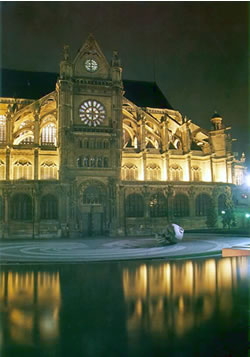 end
of the 12th century. That's right—the twelfth century. The market was
demolished in 1971, ostensibly because it was no longer large enough
to serve the city's needs, but many say it was because of all the
prostitutes and rats that had accumulated there. Head to the northern
edge of the park over to the église
St. Eustache. This is the parish church of the Halles
area, founded in the thirteenth century. It's a pretty impressive
structure on the outside, and do make sure to go inside. Even if you
don't like churches very much, it has a couple really extraordinary things inside: (1) Raymond Mason's famous "Départ des fruits et des légumes" (The Depart
of the Fruits and Vegetables). This
end
of the 12th century. That's right—the twelfth century. The market was
demolished in 1971, ostensibly because it was no longer large enough
to serve the city's needs, but many say it was because of all the
prostitutes and rats that had accumulated there. Head to the northern
edge of the park over to the église
St. Eustache. This is the parish church of the Halles
area, founded in the thirteenth century. It's a pretty impressive
structure on the outside, and do make sure to go inside. Even if you
don't like churches very much, it has a couple really extraordinary things inside: (1) Raymond Mason's famous "Départ des fruits et des légumes" (The Depart
of the Fruits and Vegetables). This  sculpture
is a tribute to the closing of the central market (actually, it was
moved out to the suburb of Rungis), and it's a strange and oddly
moving sculpture. The merchants trudge joylessly away with their
merchandise, and when you remember that when the market was closed in
1971, it finished off nearly 800 years of folks doing business in the
same place. For centuries folks—including some of the most famous
restaurateurs in the city, maybe even in the world—got their produce
and meats, etc. here. Now it's gone, and you never even got to see it.
But you can check out the sculpture. (2) A fantastic organ, and recitals are given fairly often.
sculpture
is a tribute to the closing of the central market (actually, it was
moved out to the suburb of Rungis), and it's a strange and oddly
moving sculpture. The merchants trudge joylessly away with their
merchandise, and when you remember that when the market was closed in
1971, it finished off nearly 800 years of folks doing business in the
same place. For centuries folks—including some of the most famous
restaurateurs in the city, maybe even in the world—got their produce
and meats, etc. here. Now it's gone, and you never even got to see it.
But you can check out the sculpture. (2) A fantastic organ, and recitals are given fairly often.
Even if you can't see the market
anymore, you can still participate in one of its rituals (OK,
maybe it's not as old as the market was, but still) by getting a bowl
of soupe à l'oignon just nearby in the famous Pied
de Cochon (also highlighted on the "Right Bank Restaurants" page). It's about a hundred yards
 on the same road/pathway (the rue Rambuteau, which turns into the rue Coquillière) that passes alongside the church, just to your west (or left, if you have your back to the park). The place is
open 24 hours, and
on the same road/pathway (the rue Rambuteau, which turns into the rue Coquillière) that passes alongside the church, just to your west (or left, if you have your back to the park). The place is
open 24 hours, and 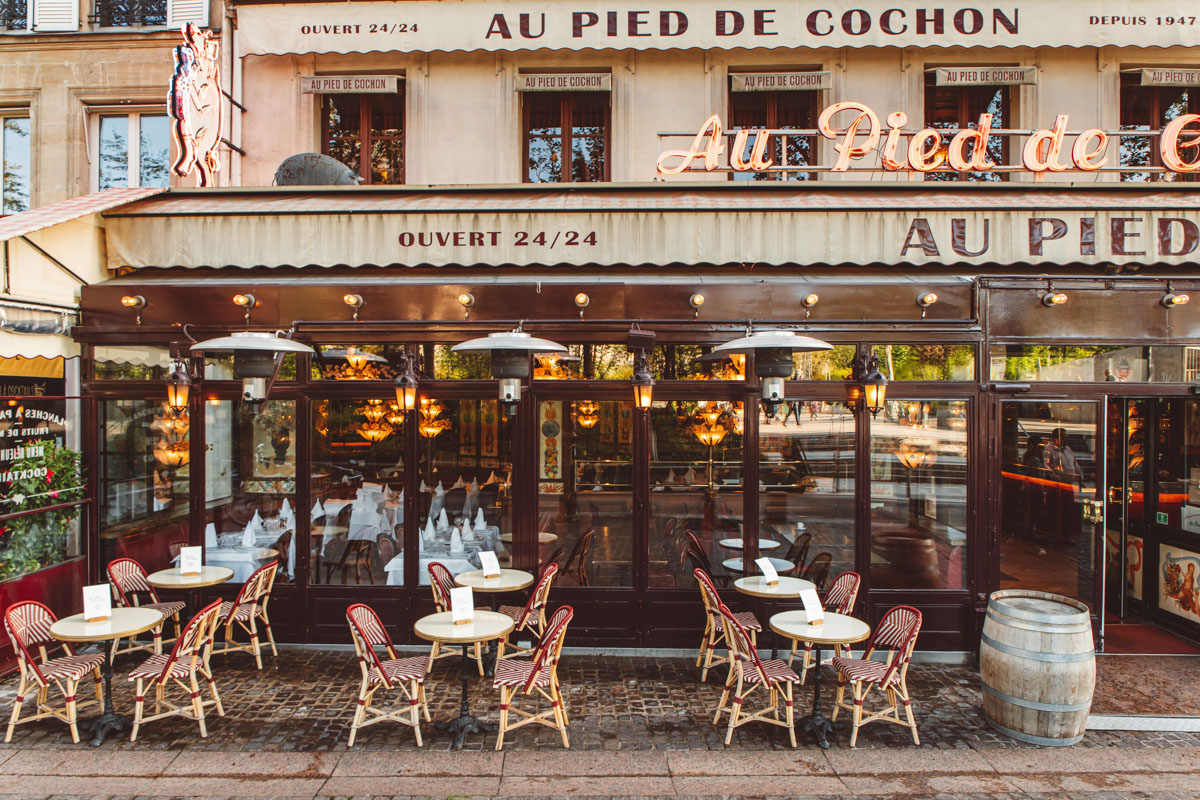 despite
its somewhat formal appearance, don't hesitate to roll on in at 3:30
am merely for a bowl of the delicious stuff. Now, go back over to the
back of St. Eustache (i.e., the east side), and take the the rue Montorgueil (careful! not the rue Montmartre), which begins
right at the eastern (pointy) tip of St. Eustache. The rue Montorgueil is a
thirteenth-century street, recently renovated (no, not for the first
time since the 13th century, smartass), and it's got an interesting
mix of slightly upscale places and real down-to-earth shops and
eateries; it's also a good market street for fruits, vegetables, flowers, meat, and charcuterie. It's largely a pedestrian street now after you cross the rue Etienne Marcel. Check out the boulangerie Stohrer (at number 51), which has been around since 1730 and is reported
despite
its somewhat formal appearance, don't hesitate to roll on in at 3:30
am merely for a bowl of the delicious stuff. Now, go back over to the
back of St. Eustache (i.e., the east side), and take the the rue Montorgueil (careful! not the rue Montmartre), which begins
right at the eastern (pointy) tip of St. Eustache. The rue Montorgueil is a
thirteenth-century street, recently renovated (no, not for the first
time since the 13th century, smartass), and it's got an interesting
mix of slightly upscale places and real down-to-earth shops and
eateries; it's also a good market street for fruits, vegetables, flowers, meat, and charcuterie. It's largely a pedestrian street now after you cross the rue Etienne Marcel. Check out the boulangerie Stohrer (at number 51), which has been around since 1730 and is reported

 to be
the oldest still operating bakery in Paris (image credit Tangopaso). As one of the world's
leading experts on pain au chocolat, Tom can attest that one
of the city's nicest can be found here. Wander around the side streets
that connect to the rue Montorgueil, but be certain to have either (a)
lunch or (b) a drink at one of these places. There's some absolutely
fantastic people-watching here. As you progress along the rue Montorgueil and continue forward, up the gentle slope, it
will change names to the rue des Petits Carreaux (and you'll cross the
busy rue Réaumur) and then to the rue Poissonnière after you pass the
rue de Cléry.
to be
the oldest still operating bakery in Paris (image credit Tangopaso). As one of the world's
leading experts on pain au chocolat, Tom can attest that one
of the city's nicest can be found here. Wander around the side streets
that connect to the rue Montorgueil, but be certain to have either (a)
lunch or (b) a drink at one of these places. There's some absolutely
fantastic people-watching here. As you progress along the rue Montorgueil and continue forward, up the gentle slope, it
will change names to the rue des Petits Carreaux (and you'll cross the
busy rue Réaumur) and then to the rue Poissonnière after you pass the
rue de Cléry.

For the next part of the walk you take a left on the rue des Jeûneurs and head over to the rue Montmartre (that's just a street name—you're not in the Montmartre district [yet]). Turn right onto the rue Montmartre, and up to the busy grands boulevards. You will be at the point where the blvd Poissonnière (on your right) turns into the blvd Montmartre (on your left). The grands boulevards were designed and implemented, largely by Georges Haussmann from the 1850s to the 1870s. They replaced medieval and later periods' cramped, crowded, and unsightly streets, and contributed to the process of modernizing Paris by making it friendly to commerce, welcoming to people of all sorts, and bringing them together to see, and it turns out, also to be seen. (Photo of the blvd Haussman by Thierry Bézecourt.)
Now you have a choice to make: (a) head on up and down the grands boulevards , which stretch from the Opera to the west on over to the Place de la République to the east—the names change, but you're essentially on the same street); or (b), you can continue straight ahead, up the rue du Faubourg Montmartre.
If you choose (a)

If you choose (a), the grands boulevards (in purple and yellow on the map), you'll probably want to head primarily to your left (east)—to the west things just get a little seedy a ways down, and you'll wind up heading toward the rue Saint Denis, and if you've been reading Tom's Guide carefully, you'll know that that's an area you might want to avoid (although in the past decade or so it's come around to being rather OK). To the left—west—on the grands boulevards (and this will be Boulevard Montmartre), however, you get into one of the ritziest areas of the right bank: upscale clothing stores, chic cafés (the elegant Café de la Paix, as seen here, for example, which people who know Tom don't think he would like, but he loves it), the spectacular Garnier Opéra, the classic Church of the Madeleine, and, if you take a slight detour, the grands magasins, the giant department stores Galeries Lafayette and Printemps.
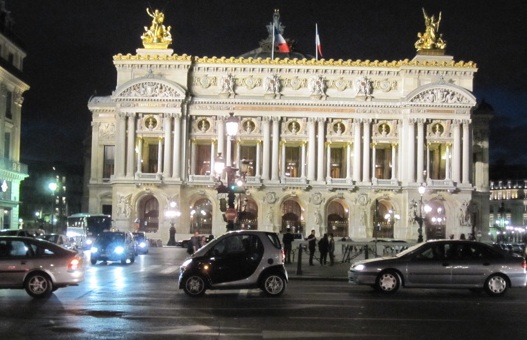 When
you get to the point on the grands boulevards where the boulevard des
Italiens diverges off to the left,
When
you get to the point on the grands boulevards where the boulevard des
Italiens diverges off to the left,
 take that route (purple on the map) if you want to see
the Opera and the Café de la Paix, and continue on to the Madeleine
(the surrounding area of which, by the way, also has some great
shopping). If you want to go to the grands magasins, keep going
straight on the boulevard Haussmann (yellow on the map), which is named after the man who is the
principal architect of modern Paris's wide streets, such as the one
you're walking on right now. You'll want to check out the Opera,
because it's so beautiful and so excessive (and at that link you can find information on how to take a tour of the building).
From here, you can either continue down the
take that route (purple on the map) if you want to see
the Opera and the Café de la Paix, and continue on to the Madeleine
(the surrounding area of which, by the way, also has some great
shopping). If you want to go to the grands magasins, keep going
straight on the boulevard Haussmann (yellow on the map), which is named after the man who is the
principal architect of modern Paris's wide streets, such as the one
you're walking on right now. You'll want to check out the Opera,
because it's so beautiful and so excessive (and at that link you can find information on how to take a tour of the building).
From here, you can either continue down the
boulevard des Capucines on
toward the Madeleine, or turn left and head down the Avenue de
L'Opéra (green on
 the map), for more upper-crust excesses. Those of you hell-bent on
checking out the Champs Elysées can keep going down the Avenue de
l'Opéra and head smack into the Jardin des Tuileries
(which is something you should see anyway), head to your west (black on the map; you'll
be able to see the Arc
de Triomphe), and just continue on, if your feet
aren't killing you by now, up the sickening Avenue des Champs
Elysées. But remember: I warned you.
the map), for more upper-crust excesses. Those of you hell-bent on
checking out the Champs Elysées can keep going down the Avenue de
l'Opéra and head smack into the Jardin des Tuileries
(which is something you should see anyway), head to your west (black on the map; you'll
be able to see the Arc
de Triomphe), and just continue on, if your feet
aren't killing you by now, up the sickening Avenue des Champs
Elysées. But remember: I warned you.
If you choose (b)
If you've taken choice (b), you're going to head straight up the rue du
Faubourg Montmartre. This is your funkier choice, and probably the
perfect antithesis of choice (a). As soon as you cross the busy grands
boulevards
 you'll feel the difference as you enter the narrow
and hectic street. First thing to see, even if it's not meal time, is
the famous Restaurant
Chartier, at 7, rue du Faubourg Montmartre. Continue
on up the street and just take in (or go in) the various strange and
wonderful shops and purveyors of food. When you get to the rue Richer (which will be on your right), you might want to head down a hundred yards or so to see the famous Folies Bergère.
The Folies Bergère opened in 1869 as a cabaret, and it evolved to include as well big-name acts in music, magic, and all sorts of entertainment. The American equivalent would likely be the Ziegfeld Folies or big Las Vegas shows (HRNet photo).
you'll feel the difference as you enter the narrow
and hectic street. First thing to see, even if it's not meal time, is
the famous Restaurant
Chartier, at 7, rue du Faubourg Montmartre. Continue
on up the street and just take in (or go in) the various strange and
wonderful shops and purveyors of food. When you get to the rue Richer (which will be on your right), you might want to head down a hundred yards or so to see the famous Folies Bergère.
The Folies Bergère opened in 1869 as a cabaret, and it evolved to include as well big-name acts in music, magic, and all sorts of entertainment. The American equivalent would likely be the Ziegfeld Folies or big Las Vegas shows (HRNet photo).
 Back on the rue du Faubourg Montmartre, keep going straight and cross
the busy rue Lafayette (some decent restaurants here) and the equally busy rue de Chateaudun. At the top of the rue du Faubourg Montmartre you'll see a church on your left (Notre Dame de Lorette). Keep going straight and a little to your right to move onto the rue des Martyrs, which extends up the slope.
Back on the rue du Faubourg Montmartre, keep going straight and cross
the busy rue Lafayette (some decent restaurants here) and the equally busy rue de Chateaudun. At the top of the rue du Faubourg Montmartre you'll see a church on your left (Notre Dame de Lorette). Keep going straight and a little to your right to move onto the rue des Martyrs, which extends up the slope.
If you can, try to time this for
around 5:00 or 6:00 in the evening, because the rue des Martyrs is an
interesting market street, with butchers, bakers, green grocers and
the like, and it's busy and fun and interesting, and you should take time to explore this area. As you approach
roughly half way up the hill, look straight ahead of you and you'll
get this really wonderful view of the top domes of Sacré
Cœur, which is where you're headed, but keep on
checking out the things around you. Keep going straight on the rue des Martyrs (actually
you'll have to bear left a little to stay on this street) to the boulevard de Clichy. Cross
over to the center strip in the middle of the boulevard to the far (north) side of the street. If you'd like, you can take a little detour here (but you'll return  back to this spot). Here and to your left (west) is the once-famous Pigalle red-light district, substantially cleaned up now, although there are some remnants of the neighborhood's sordid past.
Tom lived here some time back, and there were still some questionable establishments (called "life shows") and not a few prostitutes hanging out in the neighborhood. Anything you see now will be quite sanitized. Worth the brief detour, though, is the short trek to the famous Moulin
Rouge, at number 82, bd de
Clichy. If you want a crazy, excessive, corny, impressive, and extremely entertaining show, consider booking for one of the spectacles.
back to this spot). Here and to your left (west) is the once-famous Pigalle red-light district, substantially cleaned up now, although there are some remnants of the neighborhood's sordid past.
Tom lived here some time back, and there were still some questionable establishments (called "life shows") and not a few prostitutes hanging out in the neighborhood. Anything you see now will be quite sanitized. Worth the brief detour, though, is the short trek to the famous Moulin
Rouge, at number 82, bd de
Clichy. If you want a crazy, excessive, corny, impressive, and extremely entertaining show, consider booking for one of the spectacles.
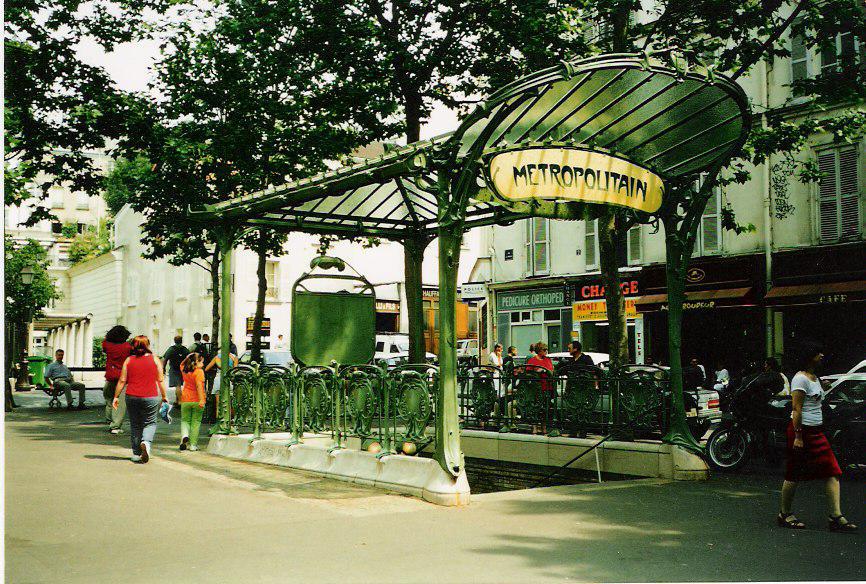 After
you've had your fill of this do a 180 and head back toward the rue des
Martyrs where this all started. Head up the steep hill (c'mon, you've
been walking around a lot
After
you've had your fill of this do a 180 and head back toward the rue des
Martyrs where this all started. Head up the steep hill (c'mon, you've
been walking around a lot
 and in you're in shape) and keep going until
you reach the rue des Abbesses. Turn left. Straight ahead you'll see
the extremely picturesque Place des Abesses. There you'll find one of
the only two remaining fully covered metro entrances. This is a
charming little square; you should have a glass of champagne at one of
the cafés. Wander around here a little bit, looking at the little
cafés and shops. You'll see that Montmartre has a whole different feel
to it, and you're going to see more.
and in you're in shape) and keep going until
you reach the rue des Abbesses. Turn left. Straight ahead you'll see
the extremely picturesque Place des Abesses. There you'll find one of
the only two remaining fully covered metro entrances. This is a
charming little square; you should have a glass of champagne at one of
the cafés. Wander around here a little bit, looking at the little
cafés and shops. You'll see that Montmartre has a whole different feel
to it, and you're going to see more.
From the place des Abbesses, look up the slope and to your right
(there may even be a little sign directing you to Sacré Coeur). Go up
the little rue la Vieuville, follow the bend around to the left (and there are
some nice little restaurants up here, including a relatively famous
vegetarian one called Au
grain de la folie at 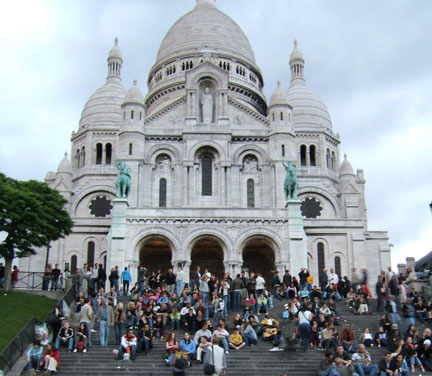 24
rue la Vieuville, and it's really tiny), until you get to the Rue
des Trois Frères (Street of the Three brothers). Now you have a choice to make: if you can handle a fair amount of stairs (or if you'd rather not), keep going straight and up the stairs right in front of you, and then turn right on the rue André Barsacq. You'll come to some more stairs on your left; go up (it's the rue Chappe, actually). At some point turn around and you'll recognize this stairway as the one that all those famous photographs depict, usually with some old person in an implausible striped jersey carrying a baguette or something. Go the rest of the way up the steps, and if you can't find Sacré Coeur on your own by now you probably shouldn't be reading this anyway. If the
basilica is still open, go in. And by all means, if you're not
claustrophobic (you should consider this carefully), climb to the very
top of the dome.
24
rue la Vieuville, and it's really tiny), until you get to the Rue
des Trois Frères (Street of the Three brothers). Now you have a choice to make: if you can handle a fair amount of stairs (or if you'd rather not), keep going straight and up the stairs right in front of you, and then turn right on the rue André Barsacq. You'll come to some more stairs on your left; go up (it's the rue Chappe, actually). At some point turn around and you'll recognize this stairway as the one that all those famous photographs depict, usually with some old person in an implausible striped jersey carrying a baguette or something. Go the rest of the way up the steps, and if you can't find Sacré Coeur on your own by now you probably shouldn't be reading this anyway. If the
basilica is still open, go in. And by all means, if you're not
claustrophobic (you should consider this carefully), climb to the very
top of the dome.
 If, however, stairs are not your thing, then when you get to the rue des Trois Frères, take a right onto that street and follow it down around the curve to the right until you get to the rue Tardieu (which picks up from the rue Yvonne Le Tac). Hang a left and after a few dozen yards you'll see the funiculary (Tom loves that word) on your left. Regular metro tickets or passes will work on this cable-car ride to the top of the hill (and you can buy them here if you don't have any).
If, however, stairs are not your thing, then when you get to the rue des Trois Frères, take a right onto that street and follow it down around the curve to the right until you get to the rue Tardieu (which picks up from the rue Yvonne Le Tac). Hang a left and after a few dozen yards you'll see the funiculary (Tom loves that word) on your left. Regular metro tickets or passes will work on this cable-car ride to the top of the hill (and you can buy them here if you don't have any).
In the evening, a little before sunset, all kinds of people gather on the steps of Sacré Cœur. People bring beer and wine, food, guitars, and it turns into a whole party atmosphere. By the time it gets dark the stairs are almost impassable. Sometimes this can be fun, but sometimes as the evening rolls on it can get a little weird—it really all depends on the crowd and the night, but it's certainly never dangerous or anything: there are way too many people around here for that. If you want to sit and enjoy the view, but you don't like the crowd, weirdly enough if you go higher up you'll see an iron fence, and you can almost always find a place to sit right beneath it. Check out more info on Montmartre at night here.
Now you can go home, go clubbing, go for a drink, or go for broke. But get ready for Strange and Interesting Walk #2.

Strange and Interesting Walk #2
Strange and interesting walk #2 starts before it starts. That is, if the timing is right and you feel like it, and the weather is good, go to a boulangerie and buy yourself something nice for lunch; don't forget to get something to drink. Pack it away, and I'll tell you when you can eat. Unlike the first walk, S&I Walk #2 takes place within a relatively constrained area—the Latin Quarter and the Ile Saint-Louis. This walk will help you get to know this area better, and it might give you some ideas for learning more about other areas.
[Notre Dame re-opened on December 7, 2024, and now you will be able to start this walk the way I wrote it before the fire of April 15, 2019.]
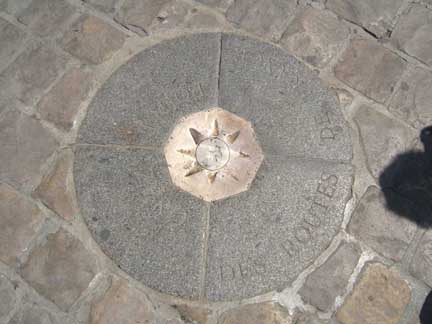 What
better place to start your next strange and interesting walk but
Kilomètre zéro—the place from which distances to Paris on the major
highways are measured? I trust you know how to get to Notre Dame. Go
there. Now, what you may well not know is that in front of the
cathedral, on the parvis, or square, is a little bronze
What
better place to start your next strange and interesting walk but
Kilomètre zéro—the place from which distances to Paris on the major
highways are measured? I trust you know how to get to Notre Dame. Go
there. Now, what you may well not know is that in front of the
cathedral, on the parvis, or square, is a little bronze  medal
embedded in the pavement. That's the zero point from which all
distances to Paris are measured. Find it and stand on it (and while
the cathedral is undergoing its renovations, stand in front of the
left-hand door as close to the fence as you can). It's about 100 feet
in front of the cathedral, pretty much between the center and
left-hand doors as you're facing the cathedral, and for the time being
because of the fire, it's inaccessible. You'll need to come back and
see this, so for the time being read the large, comic-book like panels
in front of the cathedral and then take in the scene).
medal
embedded in the pavement. That's the zero point from which all
distances to Paris are measured. Find it and stand on it (and while
the cathedral is undergoing its renovations, stand in front of the
left-hand door as close to the fence as you can). It's about 100 feet
in front of the cathedral, pretty much between the center and
left-hand doors as you're facing the cathedral, and for the time being
because of the fire, it's inaccessible. You'll need to come back and
see this, so for the time being read the large, comic-book like panels
in front of the cathedral and then take in the scene).
If the weather's nice, you'll see a lot of activity in front of the cathedral, such as skaters, mimes, puppeteers, etc. I think the skaters are pretty amazing: they'll set up ramps and do amazing jumps and things. You also sometimes see this guy who dresses up as death and stands very still in front of the cathedral. I don't quite get that.
I'm going to assume you've already visited the cathedral, so that's
not on this walk. But something that totally fascinates me is that
there's been a place of worship on the site currently occupied by
Notre Dame since at least as far back as the Romans, who dedicated a
temple to Jupiter there. Just look around you now, and realize that
the island you're standing on—the Ile de la Cité—was first inhabited
by the Parisii, a Celtic group of mostly fishermen and gamesmen (that
makes it sound like they were big gamblers, doesn't it?), and then by
the Romans, in 52 BCE, and they called this place Lutèce. It wasn't
until the middle of the 4th century that the name Paris took hold, and
pretty much everybody, including the Barbarians, invaded here. The
construction on Notre Dame started in 1165, and it took until the
thirteenth century to complete the cathedral as it was originally
envisioned. By then, the island you're standing on had someting like
thirty tiny little streets criss-crossing through it, which is kind of
hard to imagine, and there were houses built right where you're
standing on the place in front of the cathedral.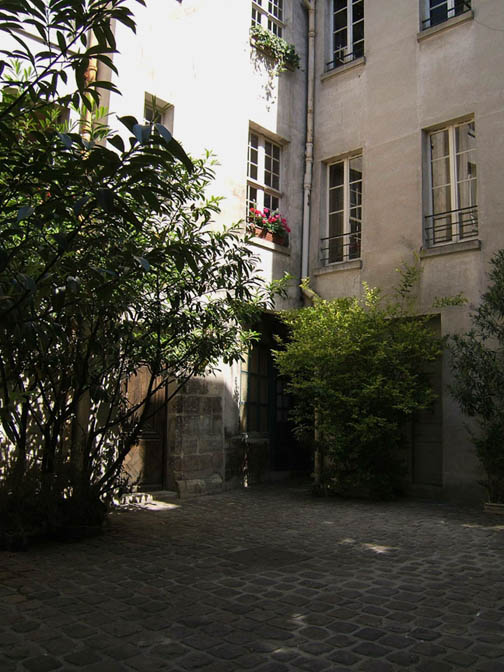
Now, to continue on the walk, assuming you're still standing on the
Kilometer Zero medal: look to the left of the cathedral, where you'll
see the the [and this is where the temporary start of the walk begins] rue d'Arcole. Head down that street and then take the next
right onto the rue Chanoinesse. You're going to be heading into some
little old streets now; if the courtyard door
 at number 26 is open, go
on in and look at the old tombstones that are used as paving stones in
the lovely courtyard (that's the courtyard pictured at right). Most of the
houses on this street are from the sixteenth or seventeenth centuries.
Retrace your steps, and take the rue de la Coulombe, and then turn
right on the rue des Ursins, following it until it turns right into
the rue des Chantres. Turn left back onto the rue Chanoinesse, and
then left on the rue du Cloître Notre Dame.
at number 26 is open, go
on in and look at the old tombstones that are used as paving stones in
the lovely courtyard (that's the courtyard pictured at right). Most of the
houses on this street are from the sixteenth or seventeenth centuries.
Retrace your steps, and take the rue de la Coulombe, and then turn
right on the rue des Ursins, following it until it turns right into
the rue des Chantres. Turn left back onto the rue Chanoinesse, and
then left on the rue du Cloître Notre Dame.
 Keep going straight onto
the lovely Pont Saint-Louis. Depending on the day and the weather you
will very likely find some interesting entertainment going on on the
bridge.
Keep going straight onto
the lovely Pont Saint-Louis. Depending on the day and the weather you
will very likely find some interesting entertainment going on on the
bridge.
Cross the bridge and then turn left onto the Quai de Bourbon. Go down the steps to the river level, and head over to the northwest "point" of the island. Sit down, unpack your lunch, and marvel at how beautiful and cool it is to have lunch in this spot. Make a mental note to thank Tom for suggesting that you do this. Enjoy your lunch, clean up, and then continue the walk.
What you should really do now is walk around the entire Ile
Saint-Louis—it's absolutely gorgeous, and it's not all that big, so
just do it (you'll have to go back up to the street 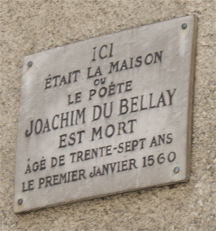 level).
As you do it, make sure to look at the many plaques above doorways
indicating famous residents of the various buildings (Du Bellay didn't
live—or die—on the Ile Saint-Louis—this is just an example). Pay
attention to #17, quai d'Anjou: that's where Baudelaire and a bunch of
his friends ran their hashish soirées. And don't ignore #9, because
Tom lived there (and so did the nineteenth-century newspaper satirist and cartoonist Honoré-Victorin Daumier, but you probably knew that). If you're tired or a wimp or otherwise not inclined
to walk around the entire perimeter of the island (and you don't know
what you're missing), then keep following the Quai de Bourbon until it
turns into the Quai d'Anjou, and then turn right onto the rue
Poulletier; take it to the rue Saint Louis en l'Ile, and then turn
right onto that street. Assuming that all sane people want good ice
cream, I now advise you to take your first right on the rue des Deux
Ponts and grab some Berthillon
ambrosia (there's more than one outlet for this, but this one's Tom's favorite). You might also be interested in taking a look at the Musée Vivant du Fromage, just a few steps further on the rue Saint-Louis en l'Ile at # 39. It's not a museum in the sense you might think, but it's def worth a visit. When you're through moaning over all the dairy you've consumed, retrace your steps on the rue
des Deux Ponts (that is, head south)—or,
level).
As you do it, make sure to look at the many plaques above doorways
indicating famous residents of the various buildings (Du Bellay didn't
live—or die—on the Ile Saint-Louis—this is just an example). Pay
attention to #17, quai d'Anjou: that's where Baudelaire and a bunch of
his friends ran their hashish soirées. And don't ignore #9, because
Tom lived there (and so did the nineteenth-century newspaper satirist and cartoonist Honoré-Victorin Daumier, but you probably knew that). If you're tired or a wimp or otherwise not inclined
to walk around the entire perimeter of the island (and you don't know
what you're missing), then keep following the Quai de Bourbon until it
turns into the Quai d'Anjou, and then turn right onto the rue
Poulletier; take it to the rue Saint Louis en l'Ile, and then turn
right onto that street. Assuming that all sane people want good ice
cream, I now advise you to take your first right on the rue des Deux
Ponts and grab some Berthillon
ambrosia (there's more than one outlet for this, but this one's Tom's favorite). You might also be interested in taking a look at the Musée Vivant du Fromage, just a few steps further on the rue Saint-Louis en l'Ile at # 39. It's not a museum in the sense you might think, but it's def worth a visit. When you're through moaning over all the dairy you've consumed, retrace your steps on the rue
des Deux Ponts (that is, head south)—or,
if you did the whole island,
head down the rue Saint Louis en l'Ile until you get to the rue des
Deux Ponts, then turn right and cross the Pont de la Tournelle (which has some excellent views). Stop
and admire the odd pylon on your left, and guess who the figure is on top (hint:
it's the patron
saint of Paris, and no, it's not Saint Paris, wise acre. Give
up?). Now look at the building just on the other side of the
bridge—that is, in the direction you're headed and on the left-side of the street you're on—and note the restaurant
at the very top, with a kick-butt view of Notre Dame. That's the
famous Tour
d'argent, where you will never, ever be able to
afford to eat. It's over 400 years old, and legend has it that the
fork was brought into France from Italy here, and if you go, get the
duck (photo credit FLLL).
 (Check out the entrance and the elevator on the ground floor, the little grocery store on the Quai de la Tournelle, and the bakery and restaurant—La Rotisserie d'Argent—directly across the little rue du Cardinal Lemoine.)
(Check out the entrance and the elevator on the ground floor, the little grocery store on the Quai de la Tournelle, and the bakery and restaurant—La Rotisserie d'Argent—directly across the little rue du Cardinal Lemoine.)
Now turn right on the Quai de la Tournelle, and head a ways, enjoying
the view of Notre Dame. You'll approach the Pont de l'Archevêché,
which you'll recognize as the spot from which a million paintings and
photographs of Notre Dame have been done; go ahead and venture out
there, take a few pictures of your own, but then come back. (This is
the point from which I took the photo that's on the home page of Tom's
Guide, reproduced here in miniature. And no, that's not me: why does
everyone keep asking 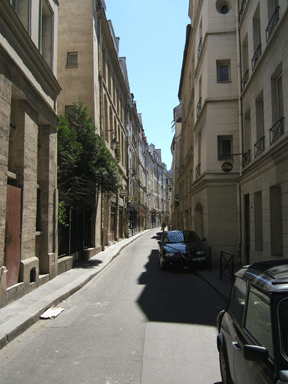 that?)
that?)
Now continue along the Quai de la Tournelle until you come to the rue
de Bièvre; turn left (the only way you can) into that pretty little
street. François Mitterand lived at #22. The Bièvre used to be a small river that emptied out into
the Seine; now it runs underground, mainly because by the 19th century it had become so polluted that authorities diverted it to the city's sewers. (The photo here is mine; but
here's a link
to Paul Rushton's stunning photograph of this street that you get to
walk down.) The story is that some of these buildings have multiple
sub-basements, the deepest of
which
it is forbidden to enter, because
they are at the same level with the Bièvre and the Seine. The first
building on the left on the rue de Bièvre is reported to have one of
these basements, which people are known to have descended into. Walk
all the way to the boulevard Saint Germain, and turn right. If it's
Tuesday, Thursday, or Saturday, between 7:00 am and about 2:30 pm,
you'll see a nice little market across the street and a little to your
right
at the Place Maubert. Go here and buy nice things to eat (especially cheeses, fruits, and vegetables) if it's open. Cross
back over the boulevard Saint Germain, head over the northeast side of
the Place Maubert, and take the little rue Maître Albert on your left.
Enjoy the little shops, restaurants, and such on this strange street. Follow the
left-bending elbow, and
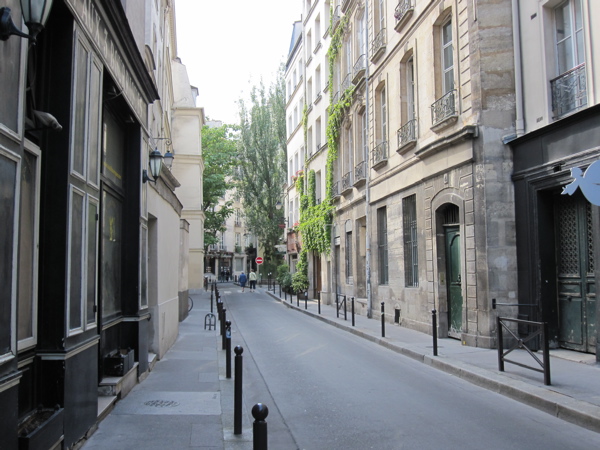 go straight until you get to the rue des
Grands Degrés (image at right). Turn left. Go straight, and cross the
rue Frédéric Sauton, and keep on this street until you come to where
the rue Lagrange meets the Quai de Montebellow. You'll note a small
park in front of you, and a little to the left a really, really old
church. Go in the park and check things out. This is Saint Julien le Pauvre, the oldest church
in Paris, and it dates to roughly the same period as the cathedral
(Notre Dame) just across the river. Now head over to the small rue
Saint Julien le Pauvre on the west side of the park (to your left as
you're facing the river). Take the small rue de la Bûcherie to your
left, and on your left you'll find the famous Shakespeare
and Company bookstore, made famous in part by beat
generation writers such as Allen Ginsberg. This incarnation of the
bookstore opened in 1951; Sylvia Beach's bookstore of the same name
was at a different location and
go straight until you get to the rue des
Grands Degrés (image at right). Turn left. Go straight, and cross the
rue Frédéric Sauton, and keep on this street until you come to where
the rue Lagrange meets the Quai de Montebellow. You'll note a small
park in front of you, and a little to the left a really, really old
church. Go in the park and check things out. This is Saint Julien le Pauvre, the oldest church
in Paris, and it dates to roughly the same period as the cathedral
(Notre Dame) just across the river. Now head over to the small rue
Saint Julien le Pauvre on the west side of the park (to your left as
you're facing the river). Take the small rue de la Bûcherie to your
left, and on your left you'll find the famous Shakespeare
and Company bookstore, made famous in part by beat
generation writers such as Allen Ginsberg. This incarnation of the
bookstore opened in 1951; Sylvia Beach's bookstore of the same name
was at a different location and  opened
in 1919 (I think). Keep heading down the rue de la Bûcherie, and cross
the busy rue du Petit Pont into the strange little rue de la Huchette.
opened
in 1919 (I think). Keep heading down the rue de la Bûcherie, and cross
the busy rue du Petit Pont into the strange little rue de la Huchette.
The little pedestrian quarter you've just entered is one of the oldest areas of Paris, and most of the little streets date back to the thirteenth century; many follow ancient Roman roads. This is a tourist Mecca (and see Tom's note on tourists), but that doesn't make it less interesting. Back in the day (i.e., the thirteenth century), this street was home to, among other things, taverns and meat roasters; you will note they still have a presence here. Oddly (or perhaps not), those sandwiches made from the rotating meat they have in the windows of many of these places turn out to be really good. If you didn't have lunch at the "point" of the Ile Saint-Louis, consider snarfing one of these guys. The hucksters who try to get you to come into their restaurants in this neighborhood can be really annoying; just ignore them if they bother you. Tom lived in this street briefly (see the double red doors in the lower right corner of the photo above left?), and oddly enough, it was remarkably quiet, because his windows opened not onto the street, but onto the lovely courtyard shielded from the noise and tourists.
As you walk down the rue de la Huchette, you'll see to your right a
very interesting sight: the narrowest street in Paris. The rue du Chat
qui Pêche (Street of the Fishing Cat) got its name from a sign
featuring that image. Most of these streets owe their names to such
signs, which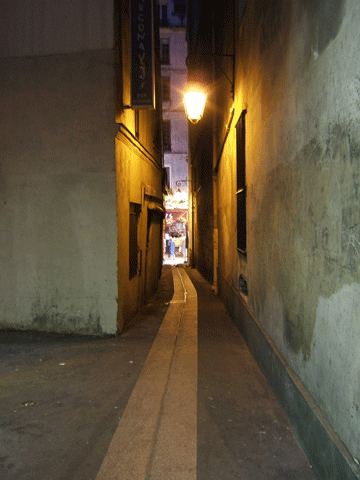 were useful for a population that didn't know how to read—arresting or
otherwise easy to remember images were both popular and useful. I took
this picture of the rue du Chat qui Pêche from the other direction
(that is, from the Seine), so it won't look this way to you.
were useful for a population that didn't know how to read—arresting or
otherwise easy to remember images were both popular and useful. I took
this picture of the rue du Chat qui Pêche from the other direction
(that is, from the Seine), so it won't look this way to you.
If you want to walk around this pedestrian area, fine. Check out the rue Xavier Privas, which is interesting because it used to be called the rue Zacharie, which was itself a deformation of "Sac-à-Lie," the sacs in which wine dregs were carried, and that was an indication of how scummy the street was—as early as the thirteenth century it was renowned for being insalubre (dangerously unhealthy). Stroll aroound for a while, and then meet me back on the rue Saint-Séverin (which you get to by turning left on Xavier Privas, and then left again on Saint-Séverin.
Check out the gorgeous gothic Saint-Séverin church,
with its eighteenth-century organ (they do concerts here). Then head
across the busy rue Saint-Jacques onto the quiet little rue Galande.
There are nice little restaurants and shops here, as well as a really
good movie theater. Keep going straight (well, follow the curve of the
road) across the rue Dante; keep going on the rue Galande, and then
turn right on the rue Lagrange; take another right, almost
immediately, on the rue des Anglais.
 Keep going straight until you're
back at the boulevard Saint-Germain. Cross the busy street, and then
head slightly to your left and up the rue Jean de Beauvais. Keep going
straight for a while (you'll cross the interesting rue du Sommerard,
wich has some nice restaurants; keep this in mind for later), and head
up the slope until you get to the rue de Lanneau. Turn left (the only
way you can turn). This is one of the oldest streets in Paris, dating
back to the end of the twelfth century. As you head down the street, look at the weird little dead
end street (rue d'Ecosse) off to your right. Now, cross the rue
des Carmes and keep going straight onto the rue de l'Ecole
Polytechnique, glancing discreetly at the Impasse des Bœufs to your
left (actually, you can be as brazen about it as you
Keep going straight until you're
back at the boulevard Saint-Germain. Cross the busy street, and then
head slightly to your left and up the rue Jean de Beauvais. Keep going
straight for a while (you'll cross the interesting rue du Sommerard,
wich has some nice restaurants; keep this in mind for later), and head
up the slope until you get to the rue de Lanneau. Turn left (the only
way you can turn). This is one of the oldest streets in Paris, dating
back to the end of the twelfth century. As you head down the street, look at the weird little dead
end street (rue d'Ecosse) off to your right. Now, cross the rue
des Carmes and keep going straight onto the rue de l'Ecole
Polytechnique, glancing discreetly at the Impasse des Bœufs to your
left (actually, you can be as brazen about it as you 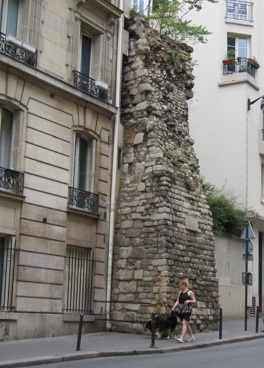 like;
I don't know why I wrote "discreetly"). Continue on straight ahead across the Placette Jacqueline-de-Romilly until the street turns into the rue Descartes. You'll see some interesting
places to grab a drink around here. Follow the curve of the road off
to the right; look down—or even go down—the weird little rue
Saint-Etienne du Mont off to your right. Come back. Now, keep going up
the slope in your original direction on the rue Descartes until you
come to the rue Clovis.
like;
I don't know why I wrote "discreetly"). Continue on straight ahead across the Placette Jacqueline-de-Romilly until the street turns into the rue Descartes. You'll see some interesting
places to grab a drink around here. Follow the curve of the road off
to the right; look down—or even go down—the weird little rue
Saint-Etienne du Mont off to your right. Come back. Now, keep going up
the slope in your original direction on the rue Descartes until you
come to the rue Clovis.
Turn left on the rue Clovis, and head to the south side of the street
(the far side from the direction you were approaching on). Get ready
to see something totally rad, now. Keep walking until you almost come
 to the end of the street. Right around address number 5, you'll see a
fragment of the Wall of Philippe II Auguste, one of the oldest walls built to protect Paris from
invaders—this dates from the early thirteenth century! In the image
at right (from OpenStreetMap contributors H. Noizet and A.-L. Bethe) you can see the walled ring around the city built during the reign of
Philippe-Auguste. My friend Kathleen lived in this neighborhood and part of the wall went directly through her apartment. Look at the wall; touch it. Now turn around and head
back up the rue Clovis from the direction you came. No dawdling.
to the end of the street. Right around address number 5, you'll see a
fragment of the Wall of Philippe II Auguste, one of the oldest walls built to protect Paris from
invaders—this dates from the early thirteenth century! In the image
at right (from OpenStreetMap contributors H. Noizet and A.-L. Bethe) you can see the walled ring around the city built during the reign of
Philippe-Auguste. My friend Kathleen lived in this neighborhood and part of the wall went directly through her apartment. Look at the wall; touch it. Now turn around and head
back up the rue Clovis from the direction you came. No dawdling.

Now keep heading straight down the rue Descartes (the same direction you had been going), noting the giant mural on the wall up to your right, and the weird little restaurants, shops, and especially bars on either side of you. Now you're approaching the very cool Place de la Contrescarpe (the name refers to the walls in a fortress), where you should stop and have a drink at one of the two excellent cafés you'll immediately see. Go ahead: take a break. Look around. Don't go to the ice cream store that might be tempting you, especially if you've already had Berthillon—no comparison (Photo by Tom Hilton).
When you're finished with your drink, keep heading down the slope
(i.e., away from the way you came on 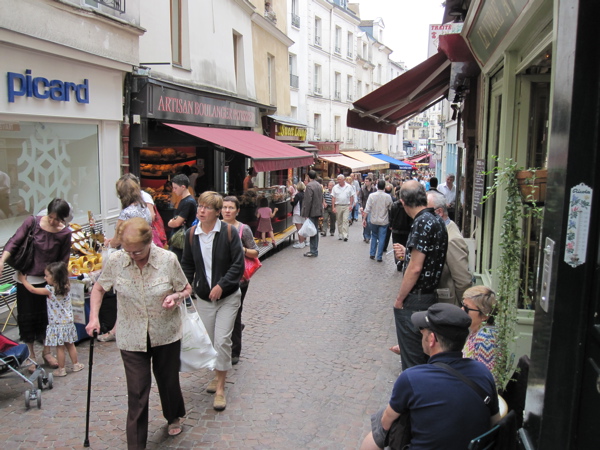 the
rue Descartes). You're now on the famous rue Mouffetard, which you've
certainly heard of, and if you haven't, where in the world have you
been? This street goes back to the thirteenth century, and you'll
notice that today it's lined with interesting (?!) shops and
restaurants. It's closed off to traffic at certain points during the
day, so you can wander around freely. Grab a pastry, a coffee, buy
some silly post cards, or do whatever you want here. Check the side
streets that you'll be passing—there are some interesting things to
note, including an excellent cinema, as you pass.
the
rue Descartes). You're now on the famous rue Mouffetard, which you've
certainly heard of, and if you haven't, where in the world have you
been? This street goes back to the thirteenth century, and you'll
notice that today it's lined with interesting (?!) shops and
restaurants. It's closed off to traffic at certain points during the
day, so you can wander around freely. Grab a pastry, a coffee, buy
some silly post cards, or do whatever you want here. Check the side
streets that you'll be passing—there are some interesting things to
note, including an excellent cinema, as you pass.
Your goal here is to make it down to the rue Daubenton, where you'll
hang a left (and have a gander at the Saint-Médard
 church right
there). Turn left on the Place Bernard Halpern, and continue straight
up the rue des Patriarches until you get to the rue de l'Epée de Bois
(street of the wooden sword). Take a right onto that street, and head
straight to the rue Monge, a busy commercial street. Turn left, and
keep going straight, and if you're a little hungry at this point, grab
something at a boulangerie or whatever, but don't eat it yet.
Keep going up the rue Monge until you get to the rue des Arènes on
your right (it's the rue Rollin on the left, but don't go that way).
Turn right on the rue des Arènes and hold your breath, because you're
going to see something amazing.
church right
there). Turn left on the Place Bernard Halpern, and continue straight
up the rue des Patriarches until you get to the rue de l'Epée de Bois
(street of the wooden sword). Take a right onto that street, and head
straight to the rue Monge, a busy commercial street. Turn left, and
keep going straight, and if you're a little hungry at this point, grab
something at a boulangerie or whatever, but don't eat it yet.
Keep going up the rue Monge until you get to the rue des Arènes on
your right (it's the rue Rollin on the left, but don't go that way).
Turn right on the rue des Arènes and hold your breath, because you're
going to see something amazing.
Follow the Rue de Navarre / Rue des Arènes around the elbow curve,
and you’ll come to an entrance on your left. Go in.
Gasp, exclaim, and be moved and surprised. Yes, it’s the Arène de Lutèce, a genuine Roman arena, right in the middle of Paris. Sit down, unpack your lunch or your pastry or whatever it was you bought, and watch the gentlemen playing boules in the arena. See what the kids are up to. This thing was built in the first century, and it could seat up to 15,000 people. Marvel at how calm and quiet it is here. Wonder how in the world they had ship battles in this space, and how much water it took and how they got it in there. Realize that you could sit here for a very long time, but then get up and leave, making sure that it doesn’t appear that you’re doing so in a huff.
Leave the arena the way you came in. Go back to the Rue Monge and
turn left; then take your
 first left on the Rue Lacepède, and head to
the Rue Linné / Rue Geoffrey St. Hilaire (it’s the next really busy
street). Turn right, and go a short distance to number 39, rue
Geoffrey St. Hilaire. Here you will find La Grande Mosquée de Paris (the Paris Mosque). Go in.
Really—it’s perfectly cool, whether you're Muslim or not (no one will
ask). Sit down in the courtyard and order a tea (thé,
pronounced “tay”). It is extremely refreshing. They also have some
pretty unusual looking but scrumptious pastries. Watch the birds.
Relax. Be calm.
first left on the Rue Lacepède, and head to
the Rue Linné / Rue Geoffrey St. Hilaire (it’s the next really busy
street). Turn right, and go a short distance to number 39, rue
Geoffrey St. Hilaire. Here you will find La Grande Mosquée de Paris (the Paris Mosque). Go in.
Really—it’s perfectly cool, whether you're Muslim or not (no one will
ask). Sit down in the courtyard and order a tea (thé,
pronounced “tay”). It is extremely refreshing. They also have some
pretty unusual looking but scrumptious pastries. Watch the birds.
Relax. Be calm.
You can end here, or, if you like plants, go across the street to the insanely large and beautiful Jardin des Plantes. Wander around here for hours until you fear you will never be able to walk again. Complain about how much your feet hurt. Go back to your hotel and soak them. Remember to send Tom an email telling him how great these 2 walks are.

Strange and Interesting Walk #3
Strange and Interesting Walk #3 will take you to a part of Paris
Tom's pretty sure you'd never go to on your own. You'll be tooling
around in the Butte-aux-Cailles neighborhood in the thirteenth
arondissement,
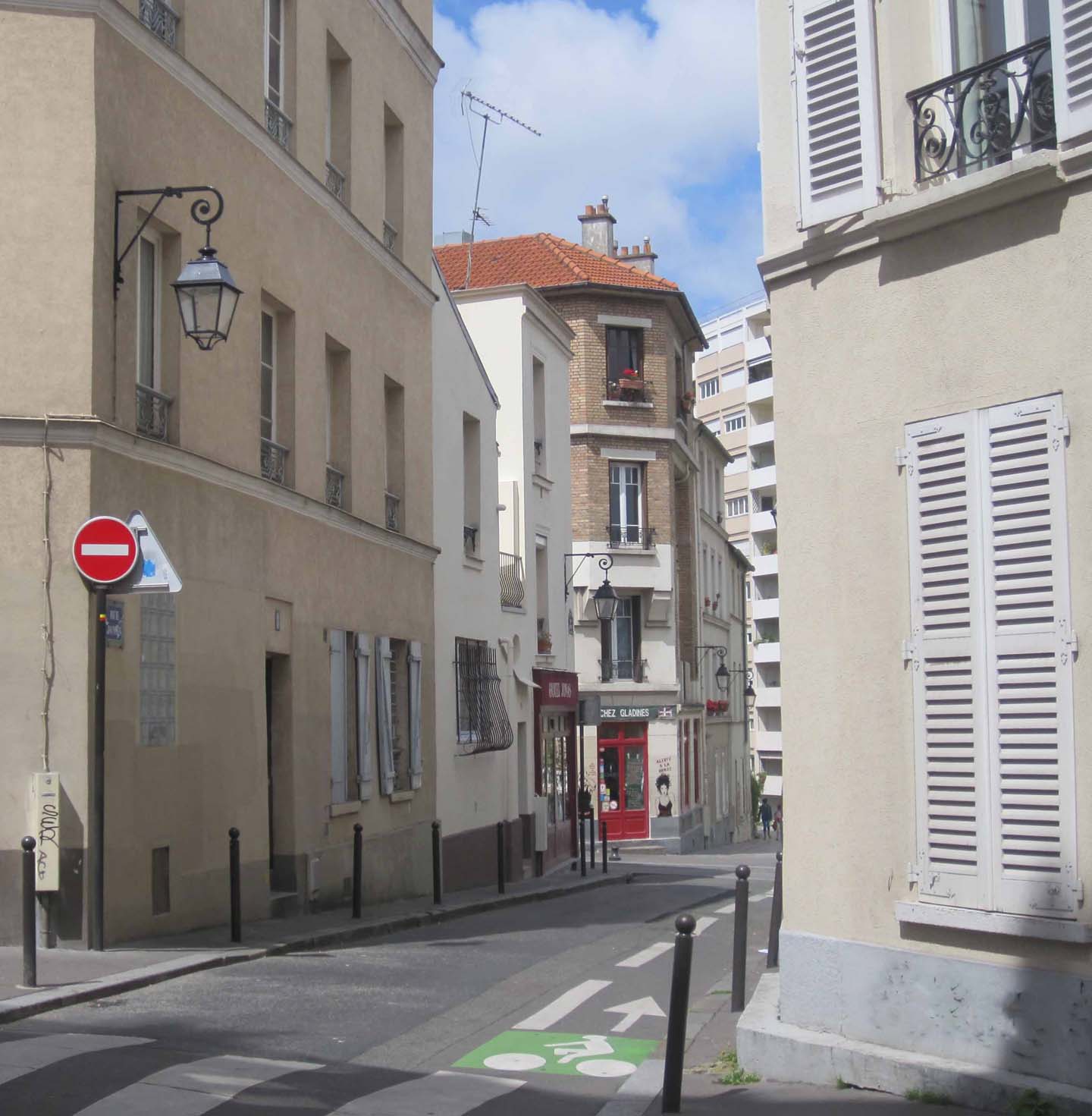 an area Tom is pretty sure you won't find in most
guidebooks. You'll be glad about this, because I can
almost promise
you there will be very few people walking around this utterly
charming, quiet, and village-like part of the city. It's so different
from the rest of Paris, in fact, that you'll feel as though you're
someplace in the south of France. This walk is not only significantly
quieter than the other two; it's also much shorter and easier to do (it's about a mile, so you can time both when you do this walk and the activities you engage in while you're doing it). Sundays are especially nice for walking around here because of how alm things are, but remember also that many establishments will be closed on that day.
an area Tom is pretty sure you won't find in most
guidebooks. You'll be glad about this, because I can
almost promise
you there will be very few people walking around this utterly
charming, quiet, and village-like part of the city. It's so different
from the rest of Paris, in fact, that you'll feel as though you're
someplace in the south of France. This walk is not only significantly
quieter than the other two; it's also much shorter and easier to do (it's about a mile, so you can time both when you do this walk and the activities you engage in while you're doing it). Sundays are especially nice for walking around here because of how alm things are, but remember also that many establishments will be closed on that day.
Start
by taking the metro to Place d'Italie. Take exit #1 (Auguste Blanqui),
and head down the rue Bobillot. (By the way, the Place d'Italie is on
the site of an old gate in the Paris wall, where goods coming into the
city were controlled and taxed.) Take your first right onto the rue du
Père Guérin. As you're walking down the street, contemplate a
 couple of things: there's lots and lots of street art here, which changes all the time; and the fact
that while the name of this neighborhood—the Butte-aux-Cailles—would
suggest that this is the Hill of Quail (which is what it means
literally), in fact, this neighborhood was named for the
sixteenth-century landowner Pierre Caille (yes, whose
couple of things: there's lots and lots of street art here, which changes all the time; and the fact
that while the name of this neighborhood—the Butte-aux-Cailles—would
suggest that this is the Hill of Quail (which is what it means
literally), in fact, this neighborhood was named for the
sixteenth-century landowner Pierre Caille (yes, whose
 name means Pete
Quail). There was a lot of mining, tanning, butchering, etc., in this
area throughout the 17th century—so much, in fact, that the area
became very polluted.
name means Pete
Quail). There was a lot of mining, tanning, butchering, etc., in this
area throughout the 17th century—so much, in fact, that the area
became very polluted.
At the end of the street, take a slight left onto the rue du Moulin des Prés (the street of the mill of the fields), and then an immediate right onto the rue Gérard. Right away you'll get the village feel here. This part of Paris wasn't incorporated into the city until the nineteenth century, which may account for the look and feel of the place.
There's not much happening on the rue Gérard, but it's very
picturesque. Check out the wild greenery to your right just as you
start into the street. You'll see Chez Djouher on your right, a good couscous and tajine restaurant, and while you're walking keep looking up at the 2nd and 3rd
 floors of buildings to see
interesting detail work. Take a look down the little rue Jonas, and
then the rue Gérard will turn into the rue Samson. Keep going straight and turn left right in front of the restaurant Apollonia onto the rue Jean Marie Jego. Head down the street and watch out for the tiger heading straight at you, and at the end of the street you'll find the extremely charming Auberge de la Butte.
floors of buildings to see
interesting detail work. Take a look down the little rue Jonas, and
then the rue Gérard will turn into the rue Samson. Keep going straight and turn left right in front of the restaurant Apollonia onto the rue Jean Marie Jego. Head down the street and watch out for the tiger heading straight at you, and at the end of the street you'll find the extremely charming Auberge de la Butte.
Now take a right onto the rue de la Butte aux Cailles, noticing as you look down the street the many restaurants, cafés, and bars that stretch out before you (there are also some shops and hairdressers). You'll note that the cafés and restaurants have a different look and feel from the ones you're used to—perhaps less chrome-y, more down to earth. You'll come across Le Temps des Cérises on your right, an interestingly eclectic place greeting students, elegant folks, and just you and me. It's also a co-op, which means the employees are majority owners. "Le Temps des Cérises—the time of the cherries—is a nineteenth-century song (in fact the song most often recorded iin France) generally associated with the French commune (1870–1871) and the ideologies and philosophies associated with it.
You're going to stay on the rue de la Butte Aux Cailles, and it will bend slightly to your left and turn into the rue de l'Espérance (street of hope!). Go a very short ways until you see
 the rue Buot to your left. Make the turn and head down that street and go all the way to the end to the rue Martin Bernard. Hang a right and go to the next street on your right—the rue Michal—and make that turn. Go up the slope and at the next intersection turn right and back onto the rue de l'Espérance (for a brief while).
the rue Buot to your left. Make the turn and head down that street and go all the way to the end to the rue Martin Bernard. Hang a right and go to the next street on your right—the rue Michal—and make that turn. Go up the slope and at the next intersection turn right and back onto the rue de l'Espérance (for a brief while).
 Follow it
around the bend to the right when it turns into the rue de la Butte aux Cailles (just keep going straight on the same street), and then turn left (the only way you can) onto the rue des Cinq Diamants (the street of five diamonds). This is a calm and quiet commercial street with shops, restaurants, and cafés. Have a look around. As you proceed along, you'll come up to a very good basque restaurant—Chez Gladines—that you might want to have a look at.
Follow it
around the bend to the right when it turns into the rue de la Butte aux Cailles (just keep going straight on the same street), and then turn left (the only way you can) onto the rue des Cinq Diamants (the street of five diamonds). This is a calm and quiet commercial street with shops, restaurants, and cafés. Have a look around. As you proceed along, you'll come up to a very good basque restaurant—Chez Gladines—that you might want to have a look at.
 This short walk finishes at the end of the rue des Cinq Diamants. To get back to the Place d'Italie just turn right on the blvd August Blanqui. You might want to explore the area around the Place or have a look at the map for some other things you might want to check out:
This short walk finishes at the end of the rue des Cinq Diamants. To get back to the Place d'Italie just turn right on the blvd August Blanqui. You might want to explore the area around the Place or have a look at the map for some other things you might want to check out: Le Parc Montsouris, the Bibliothèque François-Mittérand (the national library of France, and it's truly amazing), the Musée des Arts Forains (the fairgrounds museum, which is unbelievably interesting), the Parc de Bercy, and the Quai François Mauriac. And if you're in for another walk—but you could obviously take public transportation for this—you might also consider heading over to the catacombs.
Photo credits: National Library by Arthur Weidmann - Musée des Arts Forains by Plindenbaum.
________________
Hey! Other people like Tom's Strange and Interesting Walks.
Answer to quiz: Alright, already. It's Sainte-Geneviève. Return.
